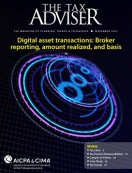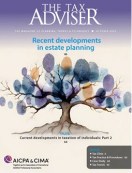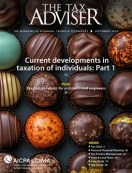- tax clinic
- expenses & deductions
IRS increases scrutiny of business aircraft use
Related
IRS clarifies health savings account changes in H.R. 1 in new notice
PTEs need more notice of changes, more time to respond, AICPA says
IRS announces prop. regs. on international tax law provisions in OBBBA
In February 2024, the IRS announced it would be significantly increasing scrutiny of the use of noncommercial business aircraft by corporations, partnerships, and high–income taxpayers (e.g., business–owned, chartered, or leased aircraft) (News Release IR–2024–46). The IRS noted it had not closely scrutinized this area in the past decade as its resources fell sharply. However, with the infusion of more than $58 billion in additional funding by the Inflation Reduction Act of 2022, P.L. 117–169 (originally $80 billion, but subsequently reduced by the Fiscal Responsibility Act of 2023, P.L. 118–5, and Further Consolidated Appropriations Act, 2024, P.L. 118–47), this new focus on business aircraft is part of the IRS’s ongoing efforts to improve tax compliance in high–income categories.
Specifically, the IRS announced plans to begin dozens of audits initially focusing on whether business aircraft use is being properly allocated between business and personal use. Personal use generally results in income inclusion by the individual using the aircraft and could also affect the business’s eligibility to deduct expenses incurred to provide the aircraft. The IRS also noted that business aircraft audits could increase in the future following the initial results and as the IRS continues to hire and train additional examiners.
In October 2024 the IRS also released (in response to a Freedom of Information Act request by Bloomberg Tax) a redacted version of its internal business aircraft tax training materials, which included a sample initial information document request (IDR) that highlights the potentially broad scope of IRS aircraft audits and the significant level of substantiation the IRS expects businesses to maintain in support of their tax treatment of business aircraft.
If they have not already done so, businesses that own, lease, or charter aircraft should prepare for this increased scrutiny by closely reviewing their compliance with the numerous tax provisions that can potentially apply to business aircraft. As the IRS noted in its February announcement, this area of tax law is complex, and recordkeeping for the purposes of substantiating compliance can be challenging.
This item is a summary of key tax issues the IRS has announced are anticipated areas of emphasis during its campaign and is not meant to address or represent an exhaustive list of relevant issues.
Background: Key business aircraft tax matters
As noted, the IRS will initially focus on the allocation between business and personal use of business aircraft. All passenger flights on a business–provided aircraft generally must be characterized as business, personal, commuting, or entertainment for certain federal income tax purposes, including, but not limited to the following:
Imputing income for personal use: A business is generally required to impute income to a service provider (e.g., employee, independent contractor, partner, board member; hereinafter collectively referred to as an “employee”) who uses the business aircraft for personal purposes. A flight for business purposes does not generally require income to be imputed because the flights are generally treated as a working–condition fringe benefit under Sec. 132(a)(3).
The amount includible in an employee’s income for personal use of a business aircraft is generally based on either (1) the fair market value of the transportation at charter rates, or (2) the standard industry fare level (SIFL) rates. Most personal flights are valued using the SIFL rates, which generally are significantly lower than charter rates.
Deduction disallowances for expenses incurred to provide and operate the aircraft: A business generally can deduct the expenses incurred to provide and operate an aircraft (e.g., depreciation, fuel, flight crew salaries, hangar fees), but only to the extent attributable to business use. However, following the Tax Cuts and Jobs Act (TCJA), P.L. 115–97, expenses incurred in connection with entertainment (both business and personal) and commuting between an employee’s residence and place of employment, although not previously fully deductible, are no longer deductible. Thus, the costs incurred to provide and operate a business aircraft, to the extent attributable to entertainment and commuting, generally are not deductible under Sec. 274.
Impact of personal use on eligibility for and recapture of bonus depreciation: The TCJA also added 100% bonus depreciation for business aircraft acquired and placed in service after Sept. 27, 2017, and before Jan. 1, 2023, if certain conditions are met. The amount phases down by 20 percentage points per year, beginning with assets placed in service during 2023. One such condition under Sec. 280F is that the plane must satisfy the “predominant–use test” in the tax year that it is placed in service. This generally is satisfied for a tax year if it is used more than 50% for “qualified business use,” which includes any use in the trade or business of the taxpayer.
If the predominant–use test is satisfied for the tax year in which an aircraft is put into service but is not met in a subsequent tax year during the recovery period, the employer generally would have to recapture a portion of the accelerated depreciation through additional income recognition — essentially equal to the amount of the depreciation deducted in prior years in excess of the amount that would have been deducted using straight–line depreciation — and then depreciate the aircraft using straight–line depreciation over the remainder of its life.
Note that there are many exceptions, carve–outs, and general common pitfalls to consider when claiming bonus depreciation that exceed the scope of this discussion.
Key concepts for characterizing flights
The IRS will be closely examining how each flight is characterized and whether there is appropriate substantiation for the characterization. If not, the IRS generally will treat each such flight as a personal–entertainment flight. That would require the value of the flight to be treated as taxable compensation to the employee and the allocable costs incurred to provide the flight to be nondeductible, among other potential adverse consequences, including penalties and interest. The key concepts for properly characterizing each flight for federal income tax purposes include (but are not limited to):
- Each flight (from takeoff to landing) generally must be characterized separately, and the characterization for each passenger on a flight must be done separately, based on the particular facts and circumstances of each passenger.
- If a passenger trip involves both business and personal activities, the trip generally can be characterized as business only if it is related primarily to the employer’s trade or business — that is, the primary purpose of the trip must be for business reasons.
- When an employee’s spouse (or other nonemployee family member or guest) accompanies the employee on a business trip, the spouse’s flight generally should not be characterized as a business flight unless it can be adequately shown that the spouse’s presence on the trip has a significant, bona fide business purpose. The spouse’s performance of some incidental service generally does not cause the spouse’s expenses to qualify as deductible business expenses.
- If a business-provided aircraft is used by any passenger for commuting, the expenses allocable to the commuting flight generally would be disallowed. “Commuting” is defined as travel by an employee “between the employee’s residence and place of employment, except as necessary for ensuring the safety of the employee” (Sec. 274(l)(1)).
- A trip that is characterized as either business or personal must also be characterized as either nonentertainment or entertainment for purposes of the deduction disallowance rules under Sec. 274, based on the principal character of the trip (Regs. Sec. 1.274-2). “Entertainment” is defined broadly to include any activity that “is of a type generally considered to constitute entertainment, amusement, or recreation” (Sec. 274(a)(1)(A)).
- Personal nonentertainment that is not commuting may still be deductible, but the scope of personal nonentertainment is not well defined and appears to be narrow. The regulations indicate that certain “routine personal” activities would not be entertainment. Other examples may include attending to business other than that of the employer, traveling for medical purposes, attending funerals, participating in charitable activities, and visiting sick relatives.
Key concepts for allocating expenses to entertainment and commuting flights
As noted above, to the extent an expense is attributable to a passenger flight that has been characterized as either entertainment or commuting, the expense is generally not deductible.
Accordingly, the expenses incurred to provide a business aircraft generally must be allocated to each entertainment or commuting passenger flight for purposes of determining the amount of the deduction disallowance under Sec. 274. There are generally four methods for allocating the employer–provided aircraft expenses to entertainment and commuting passenger flights: (1) occupied–seat method — hours; (2) occupied–seat method — miles; (3) flight–by–flight method — hours; and (4) flight–by–flight method — miles.
Each of the four allocation methods must be applied by taking into account all flights on a business–provided aircraft during the employer’s tax year. Because an employer can change the method used from year to year without having to get the IRS’s approval, many employers compute the amount of the deduction disallowance under all four methods for each tax year and use the method that produces the lowest deduction disallowance for the particular tax year.
The expenses subject to the deduction disallowance rules include all of the expenses of owning and operating the aircraft, including all fixed and variable expenses the employer would deduct in the tax year.
Other potential tax implications, including passive-activity and hobby-loss rules
Using business aircraft presents many other potential tax implications, depending on the particular facts and circumstances. For example, the passive–activity–loss rules under Sec. 469 generally provide that passive–activity expenses/losses can be used to reduce only passive income and generally cannot be carried back or forward under the net operating loss rules under Sec. 172.
For this purpose, a passive activity is generally a trade or business activity in which a taxpayer does not materially participate. Material participation is generally demonstrated by meeting one or more of the seven tests provided under Temp. Regs. Sec. 1.469–5T(a) (six safe harbors and one facts–and–circumstances test). Rental activities are generally considered per se passive activities; however, important exceptions limit the definition of a “rental activity.”
As a result, if an aircraft owned by a business is rented, leased, or chartered to either a related or unrelated party, the passive–activity–loss rules could prohibit the deduction of the expenses/losses generated by that activity. For this purpose, it is often important to distinguish between a “dry lease” (aircraft leased without a flight crew) and a “wet lease” (aircraft leased with a flight crew) because, generally, only a dry lease is considered a passive activity. In addition, the passive–activity–loss rules may be addressed by a business making a passive activity grouping election under Rev. Proc. 2010–13.
There are similar implications under the hobby–loss rules under Sec. 183, which generally apply when it is determined that an activity is not engaged in for profit.
Potential tax planning opportunities
The new focus on business aircraft tax rules should not be just about compliance and substantiation — potential tax planning opportunities also exist in applying the rules throughout the life cycle of a business aircraft. For example, when a business is considering the purchase of a new aircraft, there are opportunities to maximize bonus or other accelerated depreciation (and other deductions) if certain conditions are satisfied, including the timing of when the aircraft is first placed in service and minimizing the personal use of the aircraft in that first year.
There are also tax planning opportunities after a business aircraft is acquired and first placed in service. For example, a business can consider making a straight–line depreciation method election to reduce the overall deduction disallowance under Sec. 274 by allowing the business, in lieu of the depreciation that would be deducted in a tax year (e.g., bonus depreciation), to base the disallowance on the depreciation that would have resulted from using the straight–line method of depreciation over the class life of the aircraft.
Continuing the life cycle, there are tax planning opportunities when a business is selling its aircraft. For example, in many cases, businesses that sell their aircraft use the fully depreciated basis of the aircraft (that is, zero) when calculating the gain on the sale of the aircraft. Depending on the particular facts and circumstances, and if certain conditions are satisfied, there may be a position that any depreciation that has been disallowed under certain Code sections (e.g., Sec. 274) can be treated as tax basis and reduce the tax gain on the sale of the aircraft.
Additionally, a focus on compliance and substantiation can result in significant tax savings. For example, if income is not properly imputed for the personal use of an aircraft or the SIFL rate is not properly applied (many special rules and exceptions can easily cause unintended “foot faults”), a business generally must apply the charter–rate method, which can result in significantly higher values for personal flights and additional penalties and interest. Under the charter–rate method, the value of a flight is equal to the amount that an individual would have to pay in an arm’s–length transaction to charter the same or a comparable flight.
Substantiation and preparing for increased IRS scrutiny
As noted above, the sample IDR released by the IRS highlights the potentially broad scope of aircraft audits and the significant level of substantiation the IRS expects businesses to maintain in support of their tax positions. In this regard, the training materials explain that business aircraft, as listed property used for travel, are subject to the enhanced substantiation requirements imposed by Sec. 274(d) on all deductions associated with the aircraft.
In addition, the sample IDR includes a request for extensive categories of information, including but not limited to the following:
- The flight log (including, for each flight during a tax year, among other information, the date, origin city, destination city, flight time, and name of pilot in command);
- A passenger manifest, listing each passenger on the flight and whether they are or are related to any control employees, specified individuals, and/or 5% owners (as specifically defined in the applicable regulations) — who are subject to special rules;
- For each passenger on each flight (1) the purpose of the flight; (2) documentation to support the business relationship of each passenger; (3) contemporaneous documentation that supports the business purpose of each trip and each passenger characterized as business; and (4) if the supporting documentation is not contemporaneous, the contemporaneous supporting documentation that was relied upon to reconstruct the substantiation;
- Aircraft purchase and sale documents;
- Aircraft lease, charter, and operating agreements;
- Aircraft management contracts;
- Minutes and documents indicating the business purpose of the aircraft;
- Company policy on aircraft usage;
- The Sec. 280F qualified-business-use calculation;
- The calculations for any expense limitations or disallowance related to the aircraft; and
- Income-inclusion computations relating to the personal use of the aircraft.
Reviewing compliance
The IRS is increasing its scrutiny of business aircraft tax matters, and the expanded audit activities will be broad, requiring businesses to provide extensive documentation to substantiate their tax positions. Because this area of tax law is complex and includes many special rules, exceptions, and gray areas, businesses that own, lease, or charter aircraft should, if they have not already done so, begin to prepare by closely reviewing their compliance with the numerous tax provisions that can potentially apply to business aircraft and, to the extent necessary, supplementing the substantiation of their tax positions. In addition, businesses should work closely with advisers who are broadly experienced in this area of tax law, including all of the special rules and exceptions that can apply for both compliance and tax planning purposes.
Editors
Alexander J. Brosseau, CPA, is a senior manager in the Tax Policy Group of Deloitte Tax LLP’s Washington National Tax office. Greg Fairbanks, J.D., LL.M., is a tax managing director with Grant Thornton LLP in Washington, D.C.
For additional information about these items, contact thetaxadviser@aicpa.org.
Contributors are members of or associated with Deloitte Tax LLP or Grant Thornton LLP as noted in the byline.
This publication contains general information only and Deloitte is not, by means of this publication, rendering accounting, business, financial, investment, legal, tax, or other professional advice or services. This publication is not a substitute for such professional advice or services, nor should it be used as a basis for any decision or action that may affect your business. Before making any decision or taking any action that may affect your business, you should consult a qualified professional adviser. Deloitte shall not be responsible for any loss sustained by any person who relies on this publication.














